Content
Doubtful Jeffersonia (Vesnianka) is a primrose that produces buds in the second half of April. The inflorescences are white or pale lilac, the leaves are beautifully shaped, painted in reddish-green shades. These are undemanding plants. It is enough to water them regularly and feed them occasionally. In design, they are used as ground covers.
General description of Jeffersonia
Jeffersonia is a genus of perennial herbaceous plants from the Barberry family. The name is associated with the surname of the third president of the United States, Thomas Jefferson. The "doubtful" characteristic is associated with the disputes of Russian scientists of the 19th century, who for a long time could not decide which family to include the plant in.
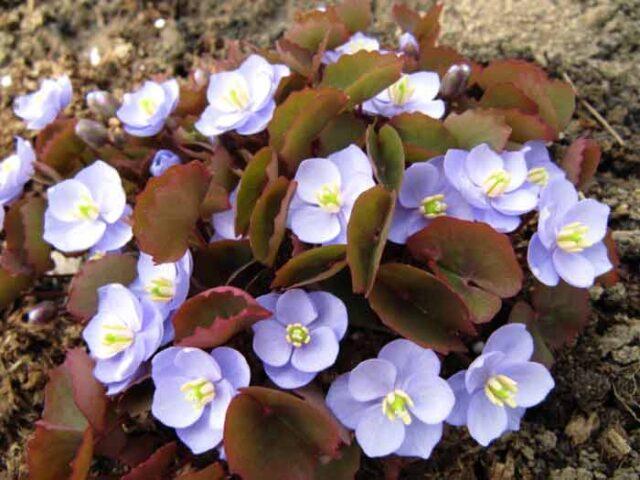
Jeffersonia is low: completely bare peduncle stem reaches 25–35 cm
All leaves are located in the root zone. The color of the leaf blades is green, with dark red shades, the venation is finger-like. Underground rhizomes.
The flowers of Jeffersonia are single, of a pleasant light lilac or pure white shade. Consists of 6 or 8 overlapping petals. They partially cover each other. As the petals open, they are somewhat removed and leave a small interval of 1–2 mm. The diameter of the inflorescences is about 2–3 cm. The stamens are free. On each flower, 8 of them are formed. The color is yellow, it contrasts well against the general background. Fruit type - a box with a falling lid. Seeds are oblong.
In natural conditions, the flower is widespread in North America (USA, Canada) and in East Asia (China, the Far East of Russia). Due to its unpretentiousness, it is grown in other places, using it to create interesting landscape design.

Sanguinaria (left) and Jeffersonia bi-leaved (right) have similar inflorescences, but different foliage
Views
The genus Jeffersonia has only two types of plants - Jeffersonia dubious and two-leaved. They have long been used to decorate the garden.
Doubtful Jeffersonia (vesnyanka)
Jeffersonia dubious (Jeffersonia dubia) in the literature and in the reviews of flower growers is also called a freckle. The fact is that it blooms in spring - from mid-April to early May (2-3 weeks). The seeds ripen in June. The buds begin to open even before the flowers appear, which is very rare among flower crops.
The foliage remains on the stems until the first frost in mid-October. Despite the fact that Jeffersonia dubious fades before the beginning of summer, it continues to be decorative throughout the season.
The leaves of the original rounded shape are located on long petioles. The color is light green with a bluish tinge. Young leaves are purple-red, after which they begin to turn green. Towards the beginning of summer, the red color remains only at the edges, which gives the dubious Jeffersonia a special appeal.
The flowers are light lilac, bluish, the height of the peduncles is not more than 30 cm. They appear in large numbers, the inflorescences alternate with the leaves. Thanks to this, a beautiful floral carpet appears in the garden.
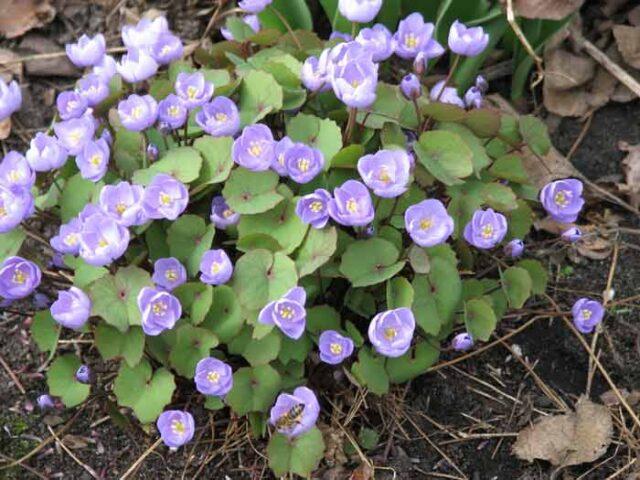
Jeffersonia dubious - one of the best soil growers that bloom in early spring
The plant can withstand temperatures up to 39 ° C.
Two-leaved Jeffersonia (Jeffersonia diphilla)
Double-leaved is another type of Jeffersony. Unlike dubious, this species has a more compact bush. At the same time, the height of the peduncles is the same - up to 30 cm. The flowering dates are later - the second half of May. The buds also open even before the final formation of the leaves.
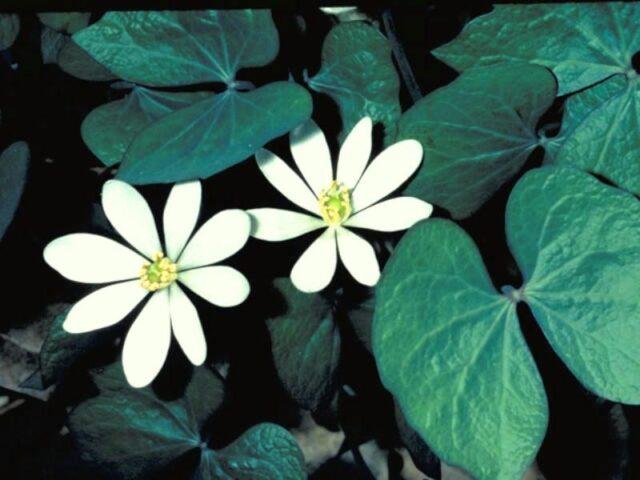
The flowers of Jeffersonia two-leaved vaguely resemble chamomile: they are snow-white, consist of eight petals, and reach 3 cm in diameter
The flowering period is 7-10 days. Seeds begin to ripen much later - by the end of July or early August. Leaves consist of two symmetrical lobes with a waist in the center. Thanks to this feature, Jeffersonia was named double-leaved. The color is saturated green, without red and purple tints.
Jeffersonia in landscaping
Jeffersonia is dubious and two-leaved - excellent ground covers that will fit well in tree-trunk circles under trees and next to bushes. They decorate nondescript places in the garden, cover the ground and fill the space. Flowers are also used in different compositions - mixborders, rockeries, borders, multi-tiered flower beds.
Below are several options for using dubious Jeffersonia (vesnyanka) in landscape design with a photo and description:
- Single landing.
- Ground cover on an open lawn.
- Trunk circle decoration.
- Landing next to a fence or building wall.
- Decorating a remote place in the garden.
Breeding features
Jeffersonia doubtful easily multiplies by dividing the bush. Also, the plant can be grown from seeds. Moreover, two methods are practiced - direct sowing into the ground and the classic version with growing seedlings.
Dividing the bush
For reproduction of doubtful Jeffersonia using division, you need to choose only adult bushes over 4-5 years old. It is better to start the procedure in late summer or early autumn. The instruction is as follows:
- Dig up a bush and shake off the ground.
- Divide the seedling into 2-3 parts so that each of them has healthy rhizomes and 3-4 shoots.
- Plant in new places at a distance of 20 cm.
- Drizzle and mulch with peat, humus, straw or sawdust.
Seed reproduction
It is possible to collect seeds of dubious Jeffersonia already in the second half of June. The capsule fruits gradually acquire a brown color - the main sign of ripening. They are carefully cut or pinched off with your fingers and laid to dry in the open air or in a ventilated area for 24 hours. Then, oblong-shaped seeds are removed.
Seed material quickly loses its germination capacity. It cannot be stored for a long time, even in the refrigerator, in wet sand or peat. Therefore, at home, you should start growing Jeffersonia from seeds immediately after they are harvested. At the same time, germination is not very high. It is better to plant obviously more material than it is planned to grow in the future.
Sowing directly into the ground
Jeffersonia is doubtful resistant to different weather conditions, therefore, it is allowed to sow stoneberry seeds directly into the open ground, bypassing the seedling stage. Planting is carried out in late June or early July. Sequencing:
- Clear and dig up the landing site in advance.
- If the soil is heavy, be sure to add sand or sawdust (800 g per 1 m2).
- Smooth the surface well and water.
- Scatter seeds over the surface (do not deepen).
- Sprinkle with moist peat on top.
In the future, no care for the seedlings of Jeffersonia dubious is required. From time to time you need to moisten the soil with a thin stream or with a spray. Seedlings will appear in a few weeks. They consist of just one sheet. For the winter they are left in the ground - you can mulch with leaf litter, and remove the layer in early spring. In the same season, the flowering of the dubious Jeffersonia will begin. Although there are often delays of 3-4 years, which is permissible for this plant.

The seedlings of Jeffersonia doubtful consist of only one leaf
Growing Jeffersonia seedlings from seeds
It is possible to grow a dubious Jeffersonia (freckle) from seeds using the classic seedling method. In this case, the material is planted in boxes or containers at the end of January. The soil mixture can be purchased at the store or made independently from light (loose) turf soil with peat and humus in a ratio of 2: 1: 1.
Algorithm of actions:
- Scatter seeds over the surface. Pre-moisten the soil.
- It is not necessary to deepen - it is enough to lightly sprinkle it with earth.
- Cover the container with transparent wrap.
- After the appearance of a full-fledged leaf, the seedlings dive in different containers.
- Water it periodically.
- They are transferred to the ground at the end of summer, planted at intervals of 20 cm, and mulched with leaf litter for the winter.
Planting dubious Jeffersonia in the ground
Caring for a Jeffersonia dubious is very simple. The plant adapts well to different conditions, so you can place seedlings almost anywhere.
Timing
Planting Jeffersonia dubious (dividing a bush or seeds) is best done in early August. This corresponds to the natural cycle of the plant: the seeds ripen in July, spread by self-sowing and have time to germinate in August-September.
Site selection and preparation
The landing site should have partial shade. A trunk circle next to a tree, shrub will do. Also, the dubious Jeffersonia can be planted on the north side, not far from the buildings. The flower does not like bright lighting, although it does not tolerate full shadow well: it may stop blooming profusely.
Also, the site should be well moisturized. The best place is on the shore of a reservoir. Otherwise, shade and a layer of mulch provide moisture retention. If the soil is fertile and loose, then it is not necessary to prepare it. But if the soil is depleted, you need to add compost or humus in the spring (3-5 kg per 1 m2). If the soil is clay, then sawdust or sand (500-800 g per 1 m2) is embedded.

Jeffersonia the dubious prefers partial shade
Landing rules
Landing is easy. On the prepared site, several shallow holes are marked at a distance of 20-25 cm. A small layer of stones is laid, a seedling of doubtful Jeffersonia is rooted and covered with loose earth (turf soil with peat, sand, humus). Water and mulch.
Care features
Jeffersonia dubious can withstand temperature fluctuations in spring and summer, as well as winter frosts, but requires moisture. Therefore, it is especially important for flower growers to monitor watering.
Watering and feeding schedule
Moistening is carried out only as necessary, making sure that the surface layer of the soil remains slightly moist. If it rains heavily, then additional moisture is not needed. If they are small, then water is given at least once a week. In case of drought, the volume of irrigation is doubled.
As a top dressing, a classic complex fertilizer is used (for example, azofoska). The granules are sprinkled on the soil and then watered. Application schedule - 2 times (May, June).
Weeding
Jeffersonia dubious looks beautiful only on a clean, well-groomed area. Therefore, all weeds must be removed periodically. To make them grow as little as possible, the soil surface is mulched when planting.
Wintering
The plant tolerates winter well, so it does not need special shelter. In the summer, it is enough to remove the faded shoots of dubious Jeffersonia. No pruning is required. In October, the bush is sprinkled with foliage or other mulch. In early spring, the layer is removed.

It is not necessary to harbor the Jefferson in the southern regions.
Even minimal maintenance guarantees a lush flowering crop.
Diseases and pests
Jeffersonia dubious has good immunity. Due to strong waterlogging, the culture can suffer from fungal diseases. If spots appear on the leaves, you must immediately remove them, and treat the bush with fungicides:
- Fitosporin;
- "Maksim";
- Fundazol;
- "Tattu".
Also, the flower can be attacked by slugs and snails. They are harvested by hand, and for prevention they sprinkle nuts or eggshells, finely chopped chili peppers around the plantings.
Conclusion
Doubtful Jeffersonia (vesnyanka) is an interesting ground cover plant that is one of the first to bloom in the garden. It does not require special attention: it is enough to water the bushes regularly, without waterlogging the ground. You can grow a crop from seeds. Often, sowing is carried out directly into the open ground.
